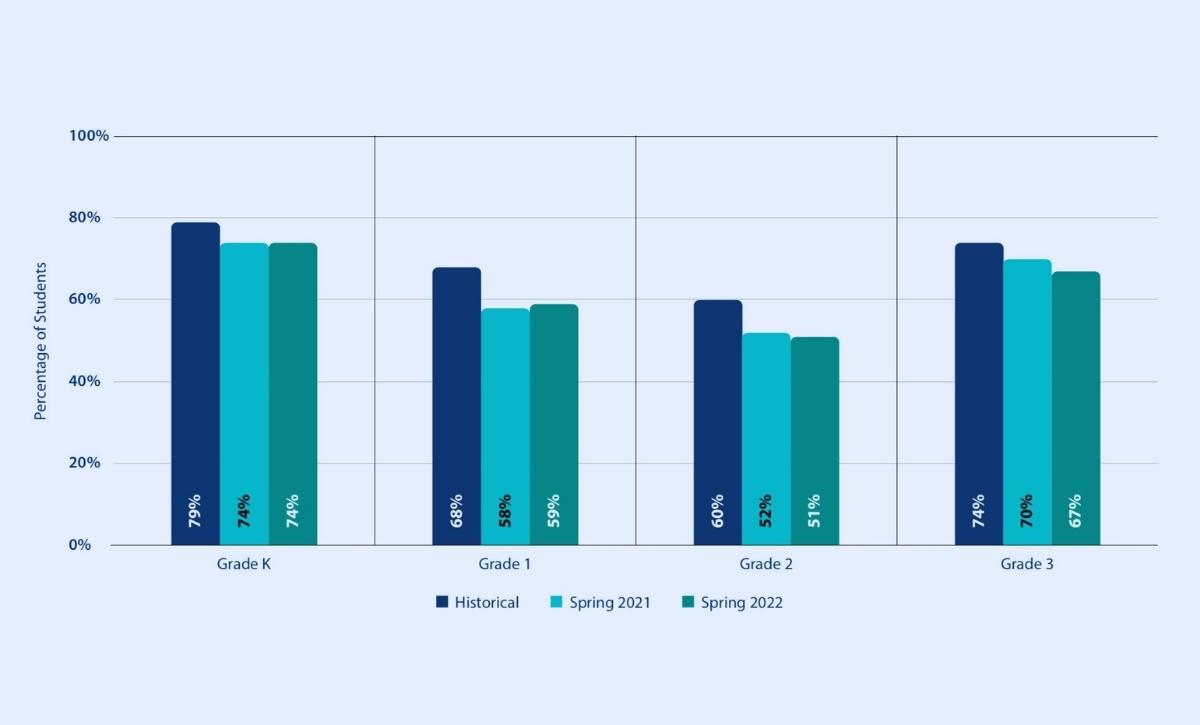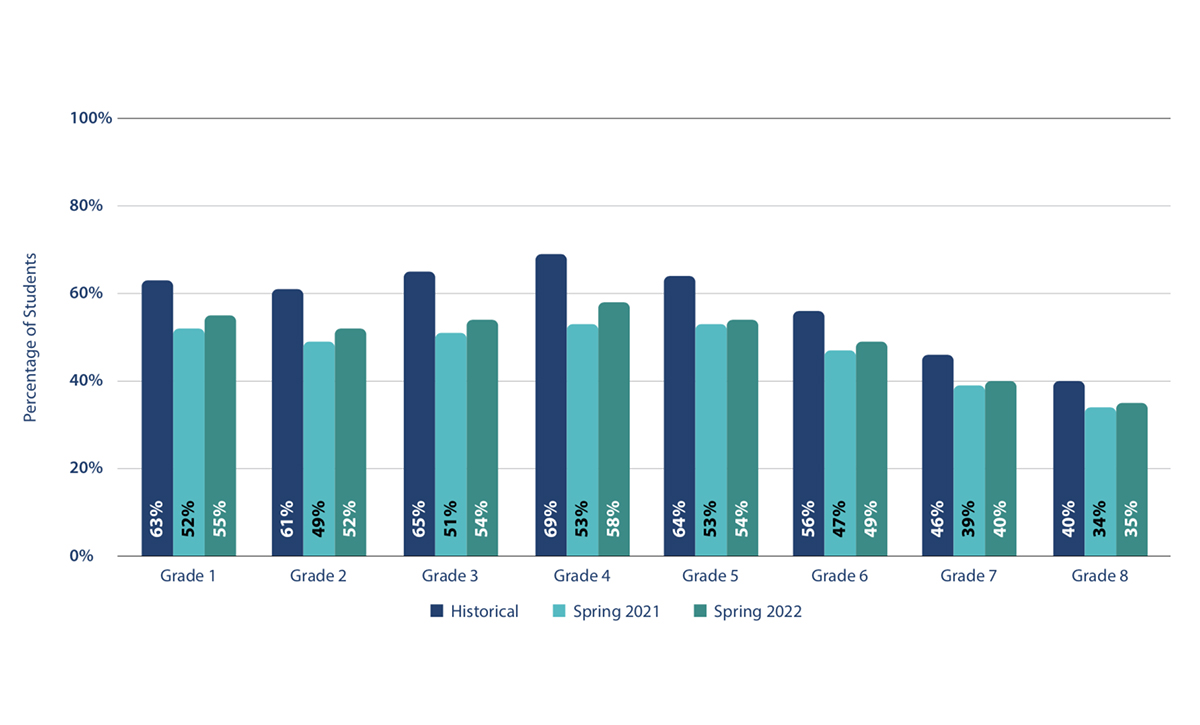New Testing Data: Fewer Students in Early Grades Developing Basic Phonics Skills
But more than 300 schools using I-Ready tests exceeded expectations, despite serving students who had fallen far behind

Get stories like this delivered straight to your inbox. Sign up for The 74 Newsletter
Test scores released Wednesday from almost 2 million students offer a glimmer of hope for parents anxious about learning loss: The percentage of older elementary and middle school students reading on grade level is nearing what it was before COVID.
But the results from Curriculum Associates, which publishes the I-Ready assessments, also reveal how much work remains to be done: Fewer children in the early grades are developing essential phonics skills, they found. In fact, even more were below grade level in the spring of 2022 than there were a year ago — in third grade, 27%, compared to 24%.
The results in math reflect a similar trend. Performance for some students is not only below what it was in the years before schools shut down; it’s worse after a year of mostly in-person learning. In grades five through eight, for example, fewer students than ever are developing essential math skills like understanding place value, multiplication and fractions.

“That first year back, they didn’t recover all the way,” said Kristen Huff, vice president of assessment and research at Curriculum Associates.
Last year, teachers had more students below grade level than ever, Huff said, and the “whole classroom dynamic changed.” Foundational math and reading skills “are the two bridges where we’re seeing those gaps endure.”
The findings follow the recent release of long-term achievement data from the National Assessment of Educational Progress, which revealed sharp declines in reading and math for the nation’s 9-year-olds. I-Ready, with results in first through eighth grade, serves a different purpose than the so-called “nation’s report card.” But the takeaways are similar: The pace of recovery is slow, and those who were struggling before the pandemic have the steepest hill to climb, particularly Black and low-income students.
Among I-Ready’s more encouraging signs, however, is that schools serving a majority of Black and Latino students saw the greatest gains in fourth grade in both reading and math. From a sample of almost 5,000 schools, over 300 exceeded expectations, despite serving students at least two years behind. Experts say the results show the need for well-targeted academic support.
“We don’t necessarily say everyone needs acceleration in all subjects for the next five years, but some kids will,” said Libby Pier, chief of staff at Education Analytics, a Madison, Wisconsin, nonprofit that monitors state data. “There are certain skills, certain students and certain schools where things are looking less or more dire.”
‘Wanted the data to tell us’
In the testing field, I-Ready is known as a diagnostic assessment — used to identify what students know and where skill gaps remain. After states canceled annual tests in 2020, schools relied more on I-Ready and similar assessments to better understand the pandemic’s impact.
“They have continued to play an important role in providing more timely information to schools about recovery efforts,” Pier said.
At Blakesburg Elementary School, among those s where students scored better than expected, Principal Tammy Davis began using I-Ready to monitor students’ reading comprehension skills and supplement a state test that focuses on fluency.
The school is located in a farming community in southeast Iowa. About 30% of students are low-income, and even though the school distributed Wi-Fi hotspots, many students lacked reliable internet during remote learning. After seeing “huge dips” in reading and math when schools reopened in the fall of 2020, teachers examined every student’s score on each category of the assessment.
“I had a feeling where we were the lowest, but I wanted the data to tell us,” Davis said.
To build comprehension skills, teachers never stopped devoting time in the school day to social studies and science — even though many districts prioritized math and reading, said April Glosser, curriculum director in the Eddysville-Blakesburg-Fremont Community School District.
“If you’re reading something that you have nothing to connect to, it’s never going to make sense to you,” she said, pointing to a passage on the sport cricket.
Teachers, she added, began to do more “think alouds” explaining to students what to do if they ran into words or phrases they didn’t recognize or understand. The school’s sixth graders, who have always struggled, Davis said, saw significant growth, from 35% proficient in spring 2021 to 56% proficient last school year. Schoolwide, 74% were proficient, getting closer to the goal of 80%.
Emerging state results
Students at Blakesburg spent most of the 2020-21 school year in person, but that wasn’t the case in many other districts. Asstates begin to release test results from last school year, researchers plan to further examine links between remote learning and student achievement.
Also Tuesday, Brown University economist Emily Oster released an analysis of state test data confirming that learning loss was greater in districts that had more remote and hybrid instruction.
In Virginia, for example, just 5% of students attended districts with “high levels of in-person instruction” during the 2020-21 school year. In 2021, the percentage of students reaching proficiency in math and English language arts was 20.5 percentage points lower than in 2019. This year, it was still 12 percentage points lower.
In Louisiana, almost two-thirds of students learned mostly in person in 2020-21. Proficiency levels in 2021 and 2022 were 5.5 and 4.1 percentage points below 2019, respectively.
“Districts that had more remote learning during the pandemic have a much longer way to go,” Oster said in a statement.
Get stories like these delivered straight to your inbox. Sign up for The 74 Newsletter

;)
